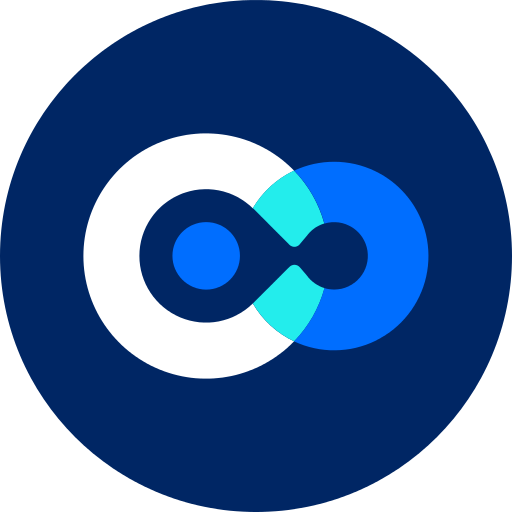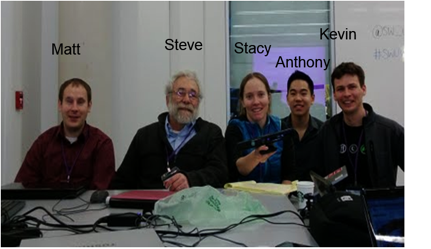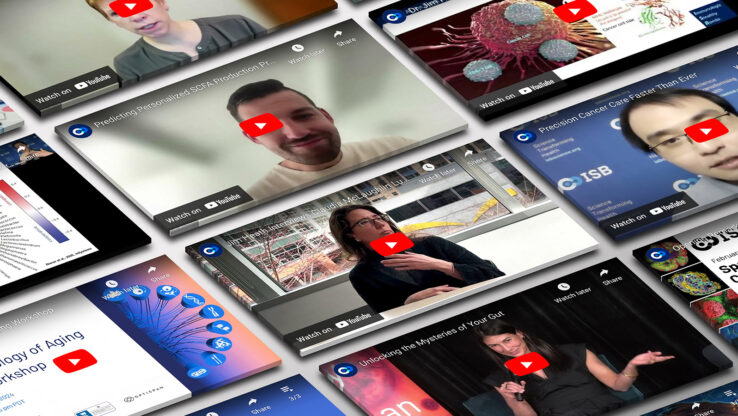A ‘Perfit’ Startup Weekend
 isbscience.org/news/2013/02/13/a-perfit-startup-weekend/
isbscience.org/news/2013/02/13/a-perfit-startup-weekend/
“Startup Weekends are 54-hour events where developers, designers, marketers, product managers and startup enthusiasts come together to share ideas, form teams, build products, and launch.”
Steven Lewis, a software engineer in the Shmulevich Group, offers a snapshot of his experience at Startup Weekend UW, which took place on Jan. 25-27. He chose to join a group that would focus on creating a virtual dressing room. The project was called PerFit.
By Steven Lewis
Our team consisted of five people. Stacy was the woman who came up with the idea and the team lead. She works at Amazon in their financial offices. Matt works for Boeing but is non-technical. Anthony is a business student. Kevin is a Microsoft evangelist.
By Saturday morning I had discovered that there were a number of competing products some of which had some pretty impressive demos. One demo in particular, which we would later emulate, showed a woman in a store reaching to virtual buttons and switching from one outfit to another. In retrospect, the outfits were fairly clumsily projected onto her body. Another company was using eight Kinects at the same time to do a body scan all at the same time. A number of other companies had sophisticated and complex hardware which they were placing in department stores.
One user had a video where he used a single Kinect to do a body scan of a number of angles of his body. This could form the basis of our program, especially if we used a Tupperware-style model where a trained woman would throw a party inviting a number of her friends to scan body images. The procedure for doing a body scan with a single sensor was way too complex for an untrained individual to perform.
We rapidly got the Kinect up and going and were able to do the standard demonstration of skeleton tracking and tracking the user replacing the background with a fixed image. We decided that these would form the basis of our demo.
Stacy went out and talk to some of her friends who concluded that the hardest problem for women was finding pants that fit. We decided that fitting pants might be what version one tried to do.
At this point, the ugly problem of clothing physics came up. Even if you know what the shape of a body is, there is no guarantee that you know what a particular article of clothing will look like on it. I found some software, largely looking at the problem of clothing for avatars in places like Second Life which addresses these issues.
One company, fits.me, had a robot that changes body shape and models clothing, and they claim a library of thousands of items. We would need them as partners. I never felt we addressed this issue well.
We also needed to come up with a logo. I tried to make a logo with a drawing of a woman which had been resized to show perfect fits using smaller images. It was a total and complete failure. When I resized the profile of a woman it simply did not line up well. In the end, I chose an image that I got off of the Internet where I am certain that the different layers were built up manually. I certainly do not have the artistic skills to do any of this.
The hardest part of the demo was explaining how we were going to make money. This was made especially difficult because there were a number of competitors many of which were reasonably well-funded. I totally failed to persuade the team to be less ambitious and go with the Tupperware model perhaps coupled with overseas tailoring. There is also a lot of competition in the custom tailoring business which causes its own problem. The two slides on making money were very ambitious and discussed revenue from the people who eventually ship the clothing together with ad revenue and of course viral growth. The second slide discussed either an IPO or being bought out by a large clothing retailer.
What we ended up doing for the demo was to make a couple of videos. One video simply showed some of the standard Kinect programs showing that we could track the body successfully. The more interesting program had Stacy modeling clothing. Stacy came in with a series of outfits. She put one on and modeled it while being tracked by the Kinect with the background being spliced in as a skiing scene. Then she would reach up and make a gesture across the body and we would stop the video. She went off and change clothes and came back to the same position. She did this a number of times. Anthony then took all of these videos and put them together adding buttons with the outfit at the spot that she had reached for. Playing all of the videos together gave the illusion that as she reached up and dragged across her body her outfit was virtually changed. In addition Anthony spliced in music to come up with a very effective presentation.
They assembled a panel of five judges from local industry. The demonstrations were before the entire group but all questions were from the judges. We presented first in part because they thought we might very well do a live demo. We had, of course, never seriously considered the possibility of a live demo and almost all of the live demos were fairly disastrous. I had considered firing up one of the standard Kinect programs during the questioning if it could work successfully figuring that we could distract the audience while dealing with tough questions. In the end we wisely decided not to do this.
The judges asked us about the competition and about another tough problem which is how to fit the clothing onto the body even if you had a body model and I have to admit that we didn’t have very good answers for either question.
So what did I learn from all this? One of the things that I learned was the importance of researching your customers and thinking about the practicality of your proposal. I am convinced that I was attracted to a technically challenging project and that was a big mistake. The better ideas are simple and you have to remember that there has to be some kind of a demo at the end of what is essentially a two day weekend. I think I would like to do this again using what I have learned on this experience and see if I can do better. I will say it was a whole lot of fun.







